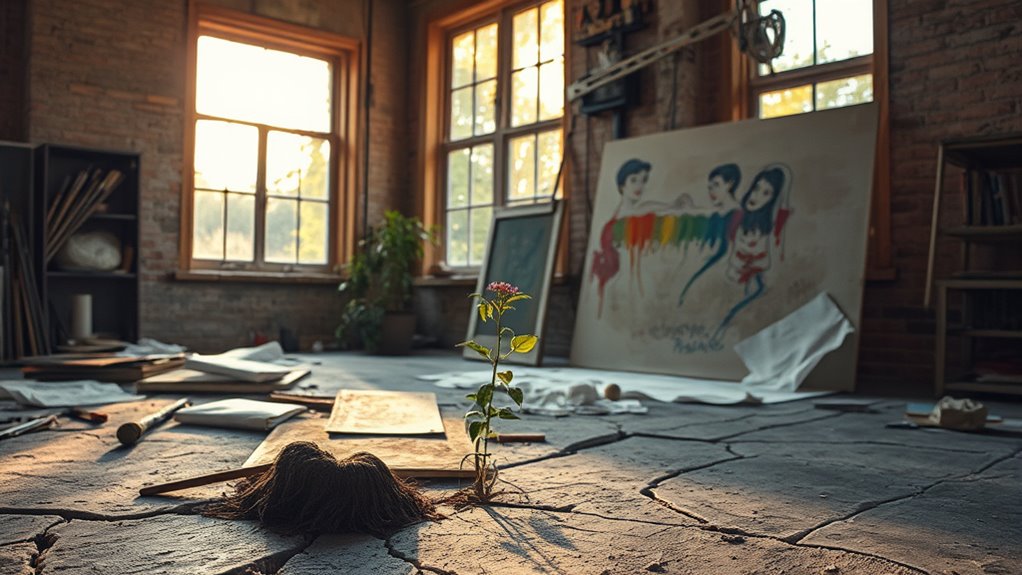To navigate failure and start over with creative resilience, you need to see setbacks as growth opportunities. Take risks outside your comfort zone, embracing uncertainty and viewing mistakes as part of the process. Practice emotional agility by managing feelings like fear or frustration and shifting your focus to constructive actions. Building confidence through repeated effort helps reinvent yourself after setbacks. Keep exploring how resilience can transform your approach to failure—you’ll discover more ways to thrive.
Key Takeaways
- Embrace setbacks as learning opportunities to foster growth and innovation.
- Practice emotional agility by observing feelings without judgment and focusing on constructive actions.
- Take calculated risks outside comfort zones to build resilience and expand creative capacity.
- Shift perspective on failure, viewing it as part of the creative process and a step toward success.
- Reinvent yourself by starting anew with energy, confidence, and a willingness to adapt and grow.

Have you ever wondered how some people turn setbacks into opportunities for growth? It’s a question that taps into the core of creative resilience—the ability to bounce back from failure and start anew with fresh energy. When you face a setback, it’s natural to feel disappointed or discouraged, but your capacity for risk taking and emotional agility can transform those feelings into powerful tools for renewal. Risk taking means stepping outside your comfort zone, trying something unfamiliar, or pursuing an idea even when failure seems possible. It’s about embracing uncertainty, knowing that growth often comes from taking those leaps. Emotional agility, meanwhile, helps you navigate the rollercoaster of emotions that accompany setbacks. Instead of being overwhelmed or trapped by negative feelings, you learn to observe them without judgment and shift your focus toward constructive actions. Together, risk taking and emotional agility create a resilient mindset that propels you forward despite setbacks.
When you approach failure as an inevitable part of the creative process, you begin to see it differently. Instead of viewing setbacks as dead ends, you recognize them as opportunities to learn and adapt. This shift requires a conscious effort to manage your emotional responses—acknowledging fear or frustration without allowing those feelings to paralyze you. Emotional agility enables you to stay flexible, to pivot when necessary, and to maintain a sense of curiosity about what’s next. It also involves regularly reviewing your progress and adjusting your strategies accordingly to reflect progress and changes. It’s about cultivating a mindset that views failure not as a reflection of your worth but as a stepping stone toward innovation. Risk taking plays a pivotal role here. When you dare to try something new, you open yourself up to the possibility of failure, but also to the potential for breakthrough. Every risk you take, no matter the outcome, strengthens your resilience and broadens your capacity to adapt.
Starting over isn’t a sign of weakness; it’s a sign of strength and resilience. You learn to see setbacks as part of the journey, an essential element of creative growth. By practicing emotional agility, you become better at managing the inevitable ups and downs, maintaining your motivation and focus even when things don’t go as planned. Taking risks keeps your ideas fresh and your spirit energized, fueling your ability to recover and reinvent. Over time, these qualities become ingrained in your approach to challenges, allowing you to see failure not as an end but as a beginning. This mindset transforms setbacks into opportunities for innovation, reinforcing your creative resilience and empowering you to keep moving forward with confidence.
Frequently Asked Questions
How Can I Rebuild Confidence After Multiple Failures?
To rebuild your confidence after multiple failures, focus on mindset shifts that emphasize growth and learning from setbacks. Surround yourself with support networks that encourage and uplift you. Celebrate small wins to boost your self-belief, and practice self-compassion during tough times. By shifting your perspective and leaning on others, you’ll regain your confidence and develop resilience, ultimately turning failures into stepping stones for future success.
What Daily Habits Foster Creative Resilience?
Think of your mind as a garden; daily habits are the seeds you plant. To foster creative resilience, practice mindset shifts like embracing failure as growth and habit formation such as journaling, mindfulness, or brainstorming. These habits strengthen your mental soil, making it easier to bounce back and innovate. Consistent, small actions build resilience over time, turning setbacks into opportunities for fresh ideas and renewed confidence.
How Do I Recognize When to Restart Completely?
You should consider restarting completely when your risk assessment shows persistent failure or burnout, and your emotional awareness signals exhaustion or loss of passion. Trust your instincts; if efforts no longer excite you or feel futile despite adjustments, it’s time for a fresh start. Recognize these signs early, evaluate your emotional state honestly, and be willing to let go of what’s no longer serving your growth.
Can Failure Be Beneficial for Long-Term Success?
Yes, failure can be beneficial for long-term success when you use it as a learning experience. By practicing risk management, you identify what went wrong and adapt your innovation strategies accordingly. Failures reveal opportunities for growth, helping you refine your approach. Embracing failure with a positive mindset encourages resilience, enabling you to bounce back stronger and more prepared for future challenges, ultimately boosting your chances of sustained success.
How Do I Balance Persistence and Knowing When to Let Go?
You should balance persistence and letting go by practicing risk management and emotional intelligence. Stay committed to your goals, but regularly assess progress and setbacks objectively. If the effort proves consistently unproductive or drains your energy, consider letting go. Trust your instincts and feelings, while also analyzing facts. This mindful approach helps you avoid burnout, make informed decisions, and maintain resilience, ensuring you pursue success without risking unnecessary exhaustion or frustration.
Conclusion
Remember, your creative resilience is your secret weapon—think of it as your own personal Swiss Army knife, ready to help you cut through setbacks and forge new paths. Like a modern-day Renaissance individual, you can turn failure into a masterpiece, just like Da Vinci might have done with a blank canvas. So, keep forging ahead; every stumble is a chance to craft a better, more vibrant story. Your next great chapter is just a step away.









